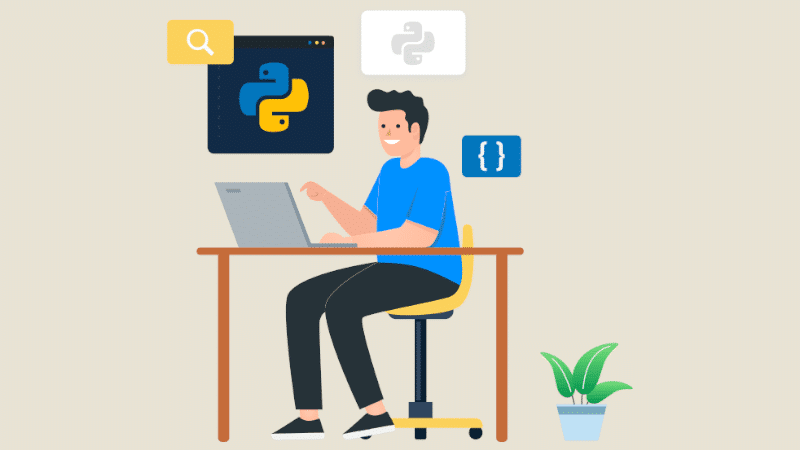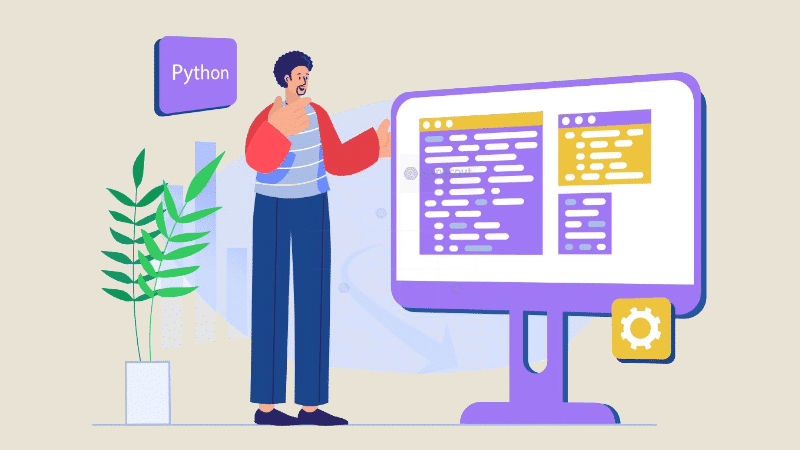Python is an open source programming language created in 1991. Over time, it has grown in popularity among application and web developers. Python is an object-oriented programming language, which means it aims to represent real-world elements in virtual form.
If you take a tour of online training centers dedicated to Data or Artificial Intelligence, you’ll surely notice that many of the curricula include Python programming right from their introduction.
It’s no coincidence that this programming language plays such an important role in Data-related courses!
Let’s take a look at what makes the Python programming language so popular, and why it’s highly advisable to take a comprehensive training course to learn how to handle its command lines.
What do Python developers do?
Python developers play an essential role in the creation of software and the back-end architecture of applications. They design programs to meet customer needs, use a variety of tools to develop efficient applications, and ensure quality through rigorous testing.
They must constantly upgrade their skills and keep abreast of the latest technologies. In addition, they are responsible for providing clear documentation to colleagues and customers.
Python is popular in the fields of data science and artificial intelligence, being used for managing and manipulating large data sets, automated information processing, and data visualization. Python developers exploit libraries such as Panda and Agate to read and organize data from a variety of sources, and to perform detailed analyses. In short, the role of a Python developer is complex and diverse, requiring technical expertise, problem-solving skills and a constant willingness to learn.

Why take a Python training course?
In a fast-growing sector where the demand for Python developers is increasing by 20% every year, taking a Python training course is a strategic choice to improve your competitiveness on the job market. Online training programs offer the opportunity to acquire Python expertise through hands-on projects and a flexible learning approach.
Python is also a major asset in the rapidly expanding field of Big Data. Companies are looking for Data Scientists capable of developing applications to exploit huge volumes of data. By obtaining a Python certification, candidates can set themselves apart, raise their profile with recruiters and effectively demonstrate their skills during interviews.
What’s more, the potential of the Python language is recognized by technology giants like Microsoft, who invest in its development and continuous improvement. So, acquiring Python skills not only means meeting current market demand, but also positioning yourself favorably for the future.
In short, training in Python represents a real opportunity to open up varied professional prospects and meet the challenges of an increasingly digital world.
What are the objectives of Python training?
The main objective of a Python training course is to equip learners with comprehensive Python skills, including learning the language’s syntax, structuring code into functions, classes and modules, and object programming in Python. This also includes implementing the various Python modules and using Python as a scripting language.
Participants will also learn how to create web applications using the Django and Django REST frameworks, develop and secure a PostgreSQL database, and enhance applications through testing, debugging and refactoring. They will become familiar with key technologies such as GitHub, Postman, HTML, CSS, JavaScript and CircleCI.
Another key objective of the course is the acquisition of practical skills. Participants will learn how to design graphical interfaces and use tools to test and evaluate the quality of a Python program. At the end of the course, they will have a portfolio of professional projects demonstrating their skills in Python.
Generally speaking, a Python training course is structured in two parts: an introduction to acquire the fundamentals of the language, followed by a refresher course to deepen knowledge and master more advanced techniques.
Throughout the course, the emphasis is on practical application through exercises and quizzes to ensure that participants really understand and master the Python language.
What is the Python training program?
Quality Python training aims to equip students with a complete and practical understanding of the Python language.
It begins by teaching the fundamental concepts of Python, from the language’s modern syntax to basics such as types, lists and functions. It also covers object-oriented programming, including classes and inheritance.
At the same time, students learn to use the language’s native features and become familiar with the standard Python library, as well as the pip package manager and PyPI repository.
In addition, the Python course focuses on the practical use of the language in real-life professional contexts. It teaches how to build websites and complete projects from A to Z, how to manage databases and how to solve problems by creating multi-platform applications.
More advanced skills are also covered, such as creating custom modules, automating repetitive tasks, managing files on the hard disk and creating command-line mini-games.
To ensure proficiency in Python development, the course covers error handling, debugging, the use of logging, the use of virtual environments, code documentation, and the use of the terminal.
Additional skills are developed, such as implementing unit tests, discovering the PyCharm IDE, creating an API and designing a Discord chatbot.
Training is often broken down into two parts: an introductory part to familiarize students with the language, and a more in-depth part to acquire more advanced skills, such as building a graphical interface using Python graphics libraries.
By the end of the course, learners will have mastered the latest version of Python and be ready to use it in a variety of professional contexts.
Salary and career development?
Once you’ve completed your training in Python application development, there are plenty of opportunities for employment and career advancement. At the start of your career, as a Python, Django, Web or Back-end developer, you can expect a gross annual salary of between €25,000 and €40,000. With experience, this salary can rise to between €45,000 and €60,000 gross per year.
Python training gives you a solid foundation for working as a developer, but it also opens the door to many longer-term career opportunities.
For example, you could choose to diversify your technical skills to become a full-stack developer. A full-stack developer is capable of managing all aspects of a web development project, from work on the back-end (the aspects of the site that are not visible to the user) to work on the front-end (the site’s user interface).
It is also possible to specialize in a particular technology. Many training courses focus on the Django framework, but there are other technical fields in which you can choose to specialize, such as Big Data or DevOps.
After gaining experience and collaborating with many other developers, you could also choose to take on a more managerial role. For example, you could become a lead developer, overseeing the work of a team of developers, or even a technical director, defining the technical direction of a company or project. In short, a Python training course provides a solid foundation for many career paths in software development.

How to finance your training?
There are several ways to finance your Python training, depending on your professional and personal situation.
For those in employment, your company’s skills development plan may be an option for financing training. It is advisable to talk to your human resources department to find out what possibilities are available.
If you are in France, there are also other schemes such as your company’s FNE-Formation and OPCO (skills operators) that can help finance your training. These schemes can offer up to 100% coverage of training costs for collective actions, or negotiated rates for “turnkey” actions.
If you are in Germany, the DataScientest courses can be funded by the Bildungsgutschein.
If you need any help regarding financing, our team will be happy to assis you.
For job-seekers, Pôle Emploi may offer financing opportunities, subject to acceptance of your application by your advisor.
Some Python training courses can be financed through the CPF (Compte Personnel de Formation).
What are the prerequisites for Python training?
To enroll in a Python training course, prerequisites vary according to the type of course and entry level. There are courses for all levels, from absolute beginners to experienced developers looking to diversify or perfect their skills in the Python language.
For beginners, there are no prerequisites – you start from scratch! All you need is a computer running Windows, Mac OS or Linux, all three of which are covered in the course.
There are also training courses for people with a good grounding in programming who want to learn the Python language. These courses can benefit employees, the self-employed and jobseekers. For these courses, prior knowledge of computer programming in another language (such as PHP, Java, C, C++, etc.) is required.
Take part in your first free data training course!
Attend live courses given by our trainers to get started with Python, SQL, Power BI…
Finally, since its inception, Python has generated a large community. This allows users to help each other and share code libraries and packages, so they don’t have to start from scratch when writing their first command line.
Python training, the foundation of Datascientest's Data training courses
At Datascientest, a Python programming module introduces the Data Scientist, Data Analyst and Data Management training courses. This introduction will enable you to discover the precious language and familiarize yourself with its functionalities through hands-on training.
At DataScientest, our training courses are based on practical work, which means you’ll be better able to integrate the lessons you’ve learned and become familiar with the programming language right from the start. Code cells, for example, are interwoven with the theoretical blocks to better test their learning.
For a complete Python training program, opt for the Data Engineer curriculum. It offers Python training including an Object-Oriented Python (OOP) component, which involves using code to create entities (objects) that can be manipulated.
These objects can interact with each other, making the code easier to understand and maintain. This also enables Python programming to be applied to real-life situations, providing a clear program structure that makes it easier to map real-world problems and their solutions.
Taking a Python training course is therefore useful not only to many companies, but also to society in general. By becoming a Python application developer and working to accurately analyze and model the data available to us, you’ll be working towards a better understanding of the world around us.











